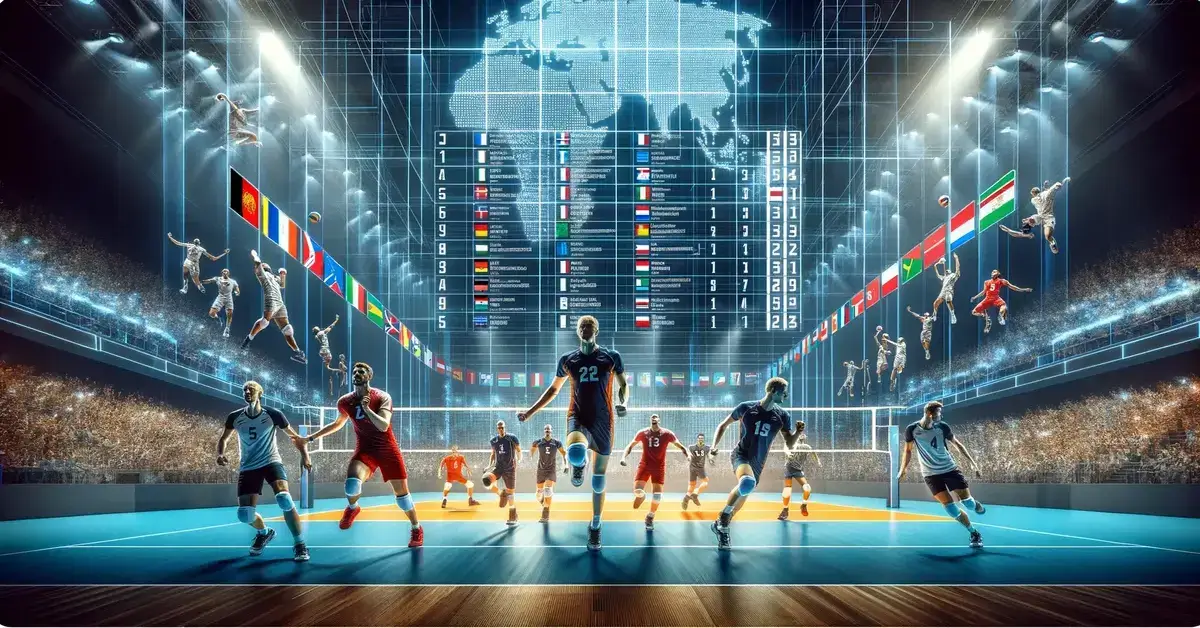One thing Philip and I are obsessed with is to check the various rankings of different teams and leagues local and all over the world regularly. Especially we are following the FIVB men’s volleyball rankings.
For those of us passionate about the sport, men’s volleyball rankings provide a fascinating snapshot of where the national teams stand in their quest for dominance on the court. For us those rankings aren’t just numbers it’s more about the excitement witnessing an underdog rise or a champion fall. Those rankings keep us hooked on the drama and the triumphs that unfold on the court.
History and Evolution of Men’s Volleyball Rankings
We’ve witnessed impressive transformations in men’s volleyball rankings over the years. As the sport has soared in popularity, the way we rank teams has evolved too. It’s like taking a journey through volleyball history, where every spike and serve has left its mark.
Initially, national teams competed in more sporadic tournaments, with their performances painting a rather incomplete picture of global standing. Yet, as volleyball’s appeal stretched worldwide, a more systematic approach was necessary.
Enter FIVB, the International Volleyball Federation. In 2021, they provided an intricate framework illustrating the prowess of various teams across the planet. Their algorithm is no simple score tally; it considers the strength of the opposition and the significance of each match.
- Major Competitions:
- Olympic Games
- World Championship
- World Cup
- World League
- FIVB’s Factors for Ranking:
- Match importance
- Opponent’s strength
- Match result
The world ranking system has become a dynamic and powerful tool. It offers a glimpse into the shifting sands of men’s volleyball, illustrating how teams from all corners of the globe compete for dominance. Rankings drive competitiveness and fuel the aspirations of nations aiming for the summit.
Our appreciation for these rankings stems from their reflections of the hard work and skill exhibited on the volleyball courts. They narrate the sport’s growth and the ascent of various teams over time. It’s not just about the points – it’s the story of men’s volleyball itself.
Current FIVB World Rankings
We’re diving straight into the details of men’s volleyball rankings, specifically the FIVB World Rankings. These are essential indicators of where national teams stand on the global stage, and we’ll also touch on how US collegiate teams are shaping up according to the AVCA polls.
Senior World Ranking
The Senior World Ranking is the definitive system by FIVB that assesses the performance of men’s national volleyball teams. It reflects a wide array of outcomes from various international competitions, with each result affecting the teams’ standings. Periodic updates ensure that the rankings stay up to date, providing a clear picture of which national teams are leading the pack.
- Top Teams: As per the latest rankings, the top tier of men’s volleyball is fiercely contested among nations that have been consistently performing at the highest level.
- Ranking Criteria: Matches played, the importance of the tournaments, and the strength of the opponents are among the factors considered in the FIVB’s complex calculation to arrive at these rankings.
National Collegiate Men’s Volleyball Poll
Moving to collegiate competition in the United States, the National Collegiate Men’s Volleyball Poll, managed by AVCA, tracks the progress of college teams throughout their season. The poll is a respected indicator for upcoming talent and the shifting dynamics at the college level.
- Frequency: AVCA releases its rankings weekly during the season, keeping fans and teams informed of their national standing.
- Ranking Considerations: Win-loss records, strength of schedule, and head-to-head competition are key ingredients in this collegiate volleyball mix, highlighting the top performers and providing insights into potential future stars on the senior circuit.
In tracking both FIVB and AVCA rankings, we stay tuned to the pulse of men’s volleyball at both the international and collegiate levels.
Top Teams and Universities
When we dive into the world of men’s volleyball rankings, notable institutions and their teams demand our attention for their consistent performance and contribution to the sport. From collegiate powerhouses in the United States to top-tier national teams across the globe, these are the entities setting the standards high in men’s volleyball.
International Dominance
- Brazil: Long reigning as a powerhouse with multiple Olympic gold medals.
- Poland: Recent years have seen a dominant presence in international tournaments.
- Russia: Known for their tactical prowess and strong physical gameplay.
See the latest FIVB men’s Volleyball World Ranking for a comprehensive list of where these teams stand.
U.S. Collegiate Rankings
- NCAA Division I Favorites:
- Stanford University: A force with high rankings both academically and athletically.
- UCLA: With multiple NCAA titles, they remain a titan in men’s volleyball.
- Penn State: Consistently a contender with a storied program.
- BYU: A team with strong traditions and a passionate fan base.
Visit NCAA Men’s Volleyball for up-to-date rankings and game results.
- NCAA Division II & III Notables:
- Lewis: Emerging strong in Division II scene.
- MIT: Combines rigorous academics with competitive volleyball.
The dynamism between the national teams and universities’ men’s volleyball programs not only pushes the sport’s envelope but also encourages a spirited community of followers around the globe.
Ranking System and Point Allocation
When we discuss men’s volleyball rankings, it is essential to understand how teams ascend or descend in international standings. The process hinges on a structured world ranking system and the meticulous allocation of points based on performance in official competitions.
World Ranking System
The FIVB Men’s Volleyball World Ranking serves as the primary index for assessing the performance levels of national teams. A WR score is assigned to each team, which reflects the total number of points they accumulate over a specific period. This score determines their position in the global hierarchy. Calculation of the WR score takes into account various international competitions where teams earn points according to their finishes. These competitions include, but aren’t limited to, World Championships, World Cups, and Olympic Games. Teams seek to maintain or improve their standing by participating in and performing well at these high-profile events.
Official Competitions Points
Points are awarded to teams based on their results at official FIVB-sanctioned events. Here’s a simplified explanation of how points are distributed at such events:
- Winning a Set: A team winning a set in an official competition contributes to the overall points earned at the event.
- Event Placement: Final placement at competitions yields different point scales, with the champions receiving the most, and each subsequent rank incrementally less.
For example, a victory at the World Championships will significantly boost a team’s points compared to lesser tournaments due to the event’s prestige and the level of competition. This system ensures that consistent high-level play at official competitions rewards teams with a higher ranking on the international men’s volleyball stage.
Beach Volleyball Rankings
We often find ourselves entranced by the dynamic sport of beach volleyball, and for enthusiasts like us, staying updated with the men’s volleyball rankings is crucial. Empowered by the Fédération Internationale de Volleyball (FIVB), the world ranking system exemplifies the competitive edge of national teams based on their performance.
The FIVB’s official ranking is a living document, frequently updated to reflect the prowess of the men’s beach volleyball teams. Here’s a glimpse into how the rankings are determined:
- Tournaments Covered: FIVB-sanctioned events over the past 365 days.
- Points System: Based on the teams’ results, with higher-tier events offering more points.
- Update Frequency: Weekly updates post any FIVB event granting points.
Current Ranking Highlights:
For enthusiasts tracking the run-up to the Olympics, the qualification process for the Paris 2024 Olympic Games includes events from February 2023 to June 2024. This intense period showcases the grit and agility of the world’s top athletes in the sand arena.
Academic associations like the AVCA (American Volleyball Coaches Association) also conduct their own AVCA polls that contribute to understanding trends and team developments.
So, for us beach volleyball fans, these rankings are more than just numbers; they narrate the ongoing saga of mastery over sand, one serve at a time.
FAQs
In the dynamic landscape of men’s volleyball rankings, every match could shuffle the deck for teams vying for the top spots. We’ve gathered some of the most common questions and provided up-to-date answers to keep you informed on where teams and players stand in the grand scheme of things.
Who is the number 1 men’s volleyball team in the world?
As of the latest update, Poland holds the prestigious position of being the number 1 men’s volleyball team in the world. Their consistent performance in official competitions has earned them this rank, reflected in the current FIVB Men’s Volleyball World Ranking.
What is South Korea men’s volleyball ranked?
The South Korean men’s volleyball team is a formidable force in Asia and has shown competitive skills in international arenas. To discover their current position in global standings, check the official FIVB ranking.
What is Brazil ranked in men’s volleyball?
Brazil has historically been a powerhouse in men’s volleyball, often finding themselves at the top of world rankings. To see their current rank and how they compare to other national teams, you can refer to the latest FIVB world rankings.
Who is the best volleyball player in the world male?
Determining the best male volleyball player in the world can be subjective, often based on recent performances and individual accolades. Players like Earvin Ngapeth, Wilfredo León, and Yuji Nishida are frequently mentioned among the elites. However, as rankings and player stats evolve, so does the list of top contenders.
We hope you could find some valuable input about men’s volleyball rankings. Tell us something about you! Are you regularly following changes in men’s volleyball rankings? Which pages do you use? What is your favorite team? Let us know in the comments.
If you liked this article you also might dive deeper into our articles about International Volleyball.






